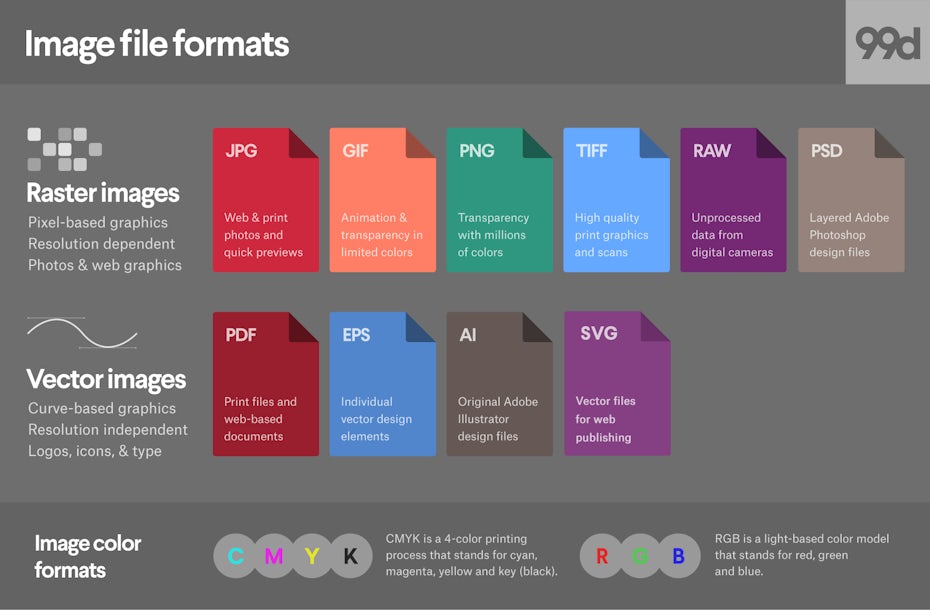Design Module 7 : Design Artwork File Types & Uses
File Types & When to Use them
Juan
Last Update één jaar geleden
Every graphic you see online is an image file that form part of a Design Artwork File Types. Most everything you see printed on paper, plastic or a t-shirt came from an image file. These files come in a variety of formats, and each is optimized for a specific use. Using the right type for the right job means your design will come out picture perfect and just how you intended. The wrong format could mean a bad print or a poor web image, a giant download or a missing graphic in an email.
So let’s break it down. Welcome to Image File Formats 101. Let’s dive into the basics of each file type.

Most image files fit into one of two general categories—raster files and vector files—and each category has its own specific uses. This breakdown isn’t perfect. For example, certain formats can actually contain elements of both types. But this is a good place to start when thinking about which format to use for your projects.
The different Design Artwork File Types of image file formats
Raster file formats
- JPEG
- GIF
- PNG
- TIFF
- RAW
- PSD
Vector file formats
- EPS
- SVG
- AI
Design Artwork File Types :
JPEG/JPG
JPEG is a lossy raster format that stands for Joint Photographic Experts Group, the technical team that developed it. This is one of the most widely used formats online, typically for photos, email graphics and large web images like banner ads. JPEG images have a sliding scale of compression that decreases file size tremendously, but increases artifacts or pixelation the more the image is compressed.
GIF
GIF is a lossless raster format that stands for Graphics Interchange Format. The big question: how is it pronounced? The creator of GIF says “JIFF” like the peanut butter. This writer (and lots of the world) says “GIFF” because graphics starts with a “guh.” Anyway, we’ll leave that up to you. GIF is also a widely used web image format, typically for animated graphics like banner ads, email images and social media memes. Though GIFs are lossless, they can be exported in a number of highly customizable settings that reduce the amount of colors and image information, which in turn reduces the file size.
PNG
PNG is a lossless raster format that stands for Portable Network Graphics. Think of PNGs as the next-generation GIF. This format has built-in transparency, but can also display higher color depths, which translates into millions of colors. PNGs are a web standard and are quickly becoming one of the most common image formats used online.
TIFF/TIF
TIFF is a lossless raster format that stands for Tagged Image File Format. Because of its extremely high quality, the format is primarily used in photography and desktop publishing. You’ll likely encounter TIFF files when you scan a document or take a photo with a professional digital camera. Do note that TIFF files can also be used as a “container” for JPEG images. These files will be much smaller than traditional TIFF files, which are typically very large.
PDF stands for Portable Document Format and is an image format used to display documents and graphics correctly, no matter the device, application, operating system or web browser. At its core, PDF files have a powerful vector graphics foundation, but can also display everything from raster graphics to form fields to spreadsheets. Because it is a near universal standard, PDF files are often the file format requested by printers to send a final design into production. Both Adobe Photoshop and Illustrator can export straight to PDF, making it easy to start your design and get it ready for printing.
EPS
EPS is an Design Artwork File Types that stands for Encapsulated PostScript. Although it is used primarily as a vector format, an EPS file can include both vector and raster image data. Typically, an EPS file includes a single design element that can be used in a larger design.
SVG
SVG stands for Scalable Vector Graphics and is an XML based vector image format for two-dimensional graphics. It can be searched, indexed, scaled and compressed and can result in smaller file sizes than other file formats, which makes it ideal for web. SVG files can be edited in graphic editing programs as well as text editors.
AI
AI is a proprietary vector image format that stands for Adobe Illustrator. The format is based on both the EPS and PDF standards developed by Adobe. Like those formats, AI files are primarily a vector-based format, though they can also include embedded or linked raster images. AI files can be exported to both PDF and EPS files (for easy reviewing and printing), and also JPEG, PNG, GIF, TIFF and PSD (for web use and further editing).

